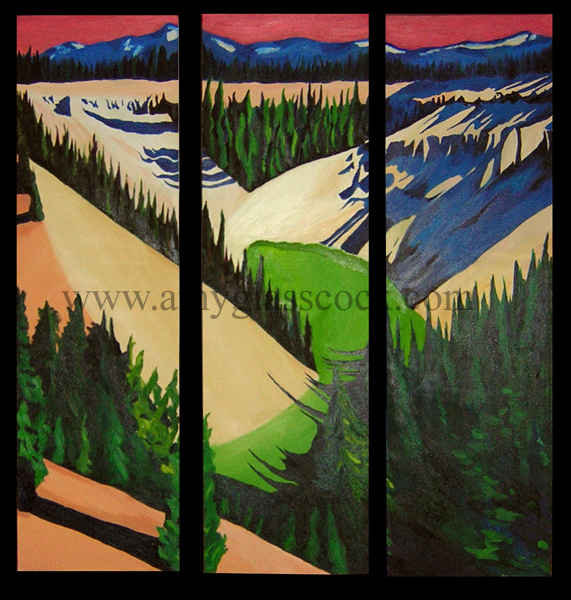Why I split
my canvases.
11.23.2004
It all started when I was in college at the University of Texas. Before my art classes, I would usually roam around the art library looking at painting books. I knew where the section was where they kept them, so I would just go up and down the aisles grabbing books and discovering different artists. One day I found this book of paintings that included one piece that caught my eye. It was a wooden screen, the type that separates a room, and it consisted of 3 panels. The painting portrayed rows of corn and was by a California artist if I remember correctly. So that was what started the wheel's turning.
As my next painting project, I decided to try splitting my canvas into three sections. My subject matter was from a photo of the forest that I had taken near Crater Lake, Oregon. As I composed the piece, I was very conscious of the repeating directional shapes in the piece, and I mainly focused on the triangular forms of the composition. The split in the canvas created more triangles, but also causes the viewer to be more active in interacting with the piece. This is because the split serves to engage their minds as they connect the shapes. I also used the points of the triangles as directional elements that serve to lead the viewer through the piece. In other words, the viewer unknowingly moves through the painting in the direction that I intended.

"Near Crater Lake, Oregon."
11/2002.
My next "breakthrough" came when I decided to play even more with the viewer's experience. In my painting, "Reno Cookie-Cutter", I purposely created places where the buildings do not continue onto the next canvas. This served two purposes. First of all, it caused the viewer to be even more engaged as they create in their own minds what fills that missing space. It also served to suggest that a larger piece of the scene was missing, thus playing with the space in the scene.

"Reno Cookie-Cutter." 3/2003.
I have also used the canvases themselves as part of the overall message in the painting. In "Maili Tano Baptist Church", I did this by making the canvases in the shape of a cross to emphasize the fact that the subject was indeed about a church. I also used the canvas shape compositionally to emphasize the branches and draw attention to the church service in the foreground below.

"Maili Tano Baptist Church."
10/2004- 11/2004.
These are just a few of the ideas that I have played with in my paintings so far. Honestly, I am still learning and discovering all of the possibilities. The more I think about why I split the canvases, the more I realize how much my work is about memory. Each painting that I do is based on a moment that I have experienced. When you remember something, you only capture bits and pieces of the reality. No matter how hard you try, pieces and details of what really happened are forever lost to us. We are thus left with an essence of that moment and for some reason or another, our memory consists of the things that made an impression on us no matter how seemingly insignificant the substance of that memory may be. The experience somehow shaped who you are today and forever changed the way that you see the world. So part of the reason that I enjoy splitting my canvases is because I think it is fitting to admit that I don't remember everything just as it was. I want the viewer to be left with the same feeling of trying to figure out how it connects because it is the same way that I feel when I remember as my mind somehow connects the dots... I want the viewers mind to do the same.
So far this is what I have discovered about my work. The more I paint the more I will understand. I hope that this gives you insight.
